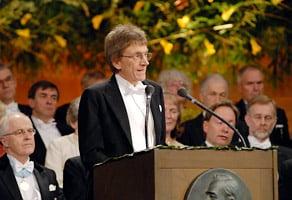Award ceremony speech

Professor Bertil Holmlund delivering the Presentation Speech for the Sveriges Riksbank Prize in Economic Sciences in Memory of Alfred Nobel 2006 at the Stockholm Concert Hall.
Copyright © The Nobel Foundation 2006
Photo: Hans Mehlin
English
Swedish
Presentation Speech by Professor Bertil Holmlund, Member of the Royal Swedish Academy of Sciences, December 10, 2006.
Your Majesties, Your Royal Highnesses, Honoured Laureate, Ladies and Gentlemen,
Low unemployment and low inflation are central goals of economic policy. During the 1950s and 1960s, the dominant perception was that a fundamental tradeoff existed between these two goals. Actual experience seemed to indicate that there was a stable relationship between unemployment and inflation, the so-called Phillips curve. The conclusion was that unemployment could be reduced if policy makers allowed a higher inflation rate, for example by means of tax cuts or interest rate cuts that stimulate demand.
Edmund Phelps challenged this view. Starting in the 1960s, he developed a new theory of unemployment and inflation that highlighted the role of inflation expectations as well as information problems in the labour market. Individual firms and households must base their decisions on expectations of the general trend of prices and wages. Phelps characterised this behaviour as the so-called expectations-augmented Phillips curve, which implies that inflation depends not only on unemployment but also on the expected inflation rate.
Phelps’s hypothesis meant that in the long run − when actual inflation also becomes expected inflation − there will be no relationship at all between inflation and unemployment. Unemployment in the long run − so-called equilibrium unemployment − is determined by how the labour market and other markets function. Monetary policy and other stabilisation policy can thus only influence short-term fluctuations in unemployment, but not the long-term unemployment level. Systematic attempts to keep unemployment below the equilibrium unemployment level by means of monetary and fiscal policy result in continuously rising inflation.
Nowadays there is convincing evidence that Phelps’s hypothesis was essentially correct. It is worth noting that it was presented at a time when the data actually contradicted his hypothesis. But events during the 1970s, when high inflation and high unemployment coincided, served to confirm Phelps’s hypothesis.
Phelps’s analysis emphasised that stabilisation policy resembles investment decisions, in the sense that the current policy has consequences on future possibilities of achieving low unemployment and low inflation. This perspective on monetary policy has become generally accepted today. Research on monetary policy, along with much of the discussion on economic policy, nowadays deals with the tradeoff between short-term changes in economic activity and future possibilities to keep unemployment and inflation down. Large portions of the theoretical underpinnings for today’s policies in this field are based on Phelps’s analysis.
Capital formation is also a matter of tradeoffs between the short run and the long run. By saving, we can make room for investments that enhance the welfare of coming generations. But future generations are not present and cannot vote for their interests. The question then becomes how we behave as parents: how much do we choose to consume for ourselves and how much do we invest for the benefit of coming generations? Edmund Phelps has clarified the intricate distributional conflicts among generations that may arise when each generation determines how much either to save or consume and hence made it possible to show that a mandatory pension system can benefit all generations.
But capital formation is not only a matter of saving and investing in physical capital. It is also about education and research − so-called human capital. In a number of publications, Edmund Phelps has called attention to the central role that investments in such knowledge capital play in economic growth. Phelps’s analysis leads to the insight that economic growth depends not only on the growth rate of the educational level, as would mainly be expected, but also on the actual educational level at a given point in time − a pattern that closely matches the outcome of empirical research.
Dear Dr Phelps: You were the first to conduct a formal and realistic analysis of unemployment and inflation where the role of inflationary expectations was taken seriously. You developed the expectations-augmented Phillips curve and examined how stabilisation policy could be conducted in this setting. You also pioneered the analysis of labour markets where informational problems are pervasive. Your work on capital formation has helped us understand intergenerational economic conflicts and the important role of human capital in economic growth.
It is an honour and a privilege to convey to you, on behalf of the Royal Swedish Academy of Sciences, our warmest congratulations. I now ask you to receive your Prize from his Majesty the King.
Nobel Prizes and laureates
Six prizes were awarded for achievements that have conferred the greatest benefit to humankind. The 12 laureates' work and discoveries range from proteins' structures and machine learning to fighting for a world free of nuclear weapons.
See them all presented here.
